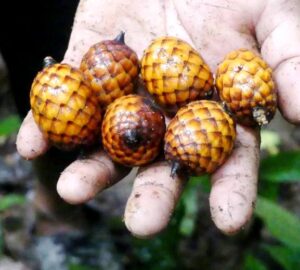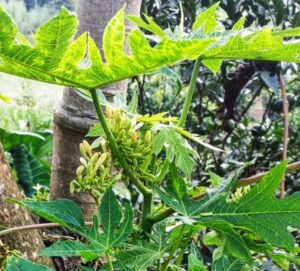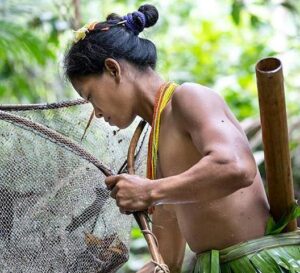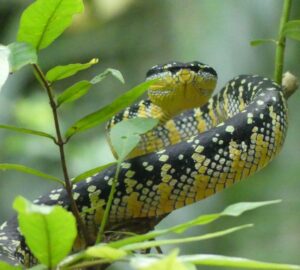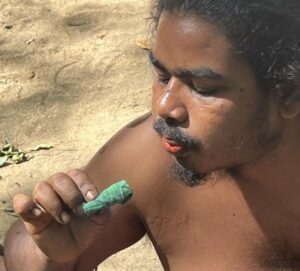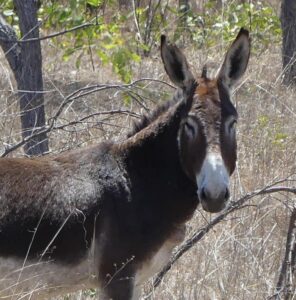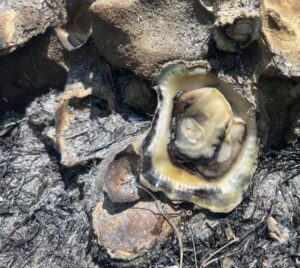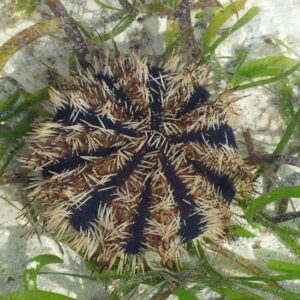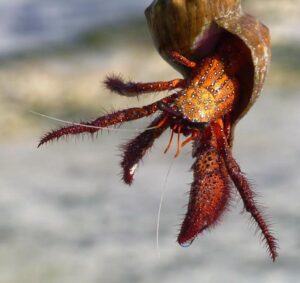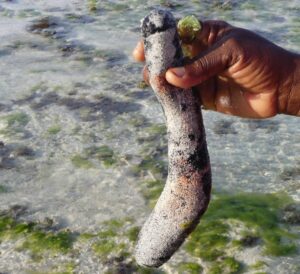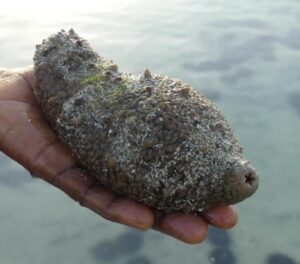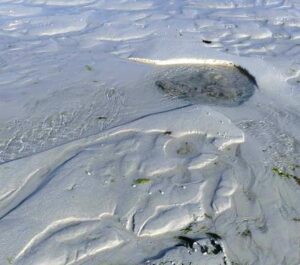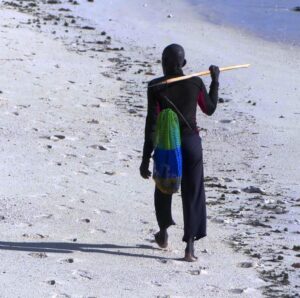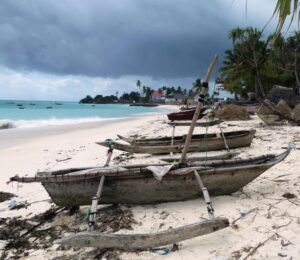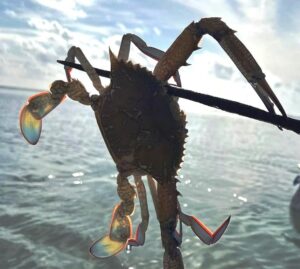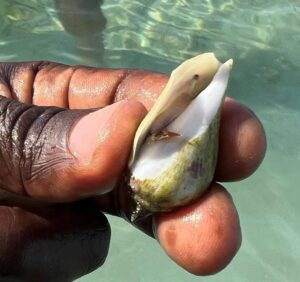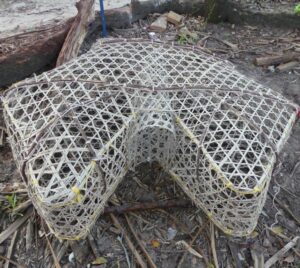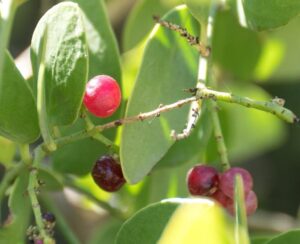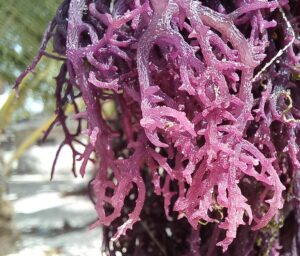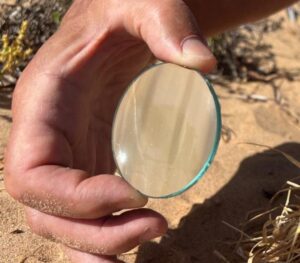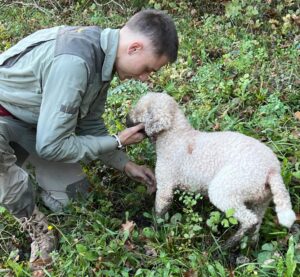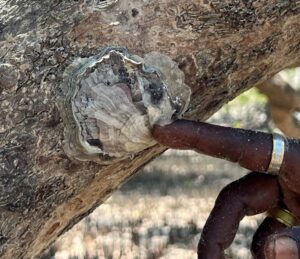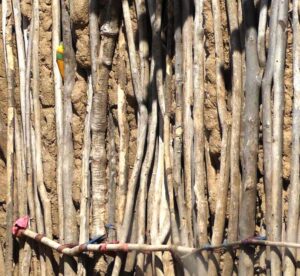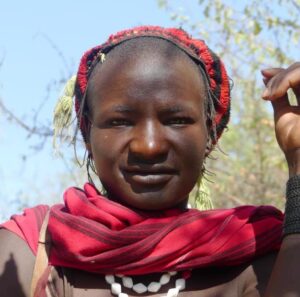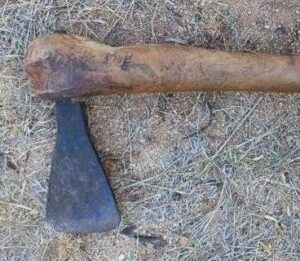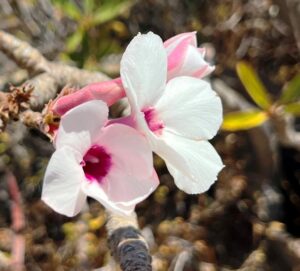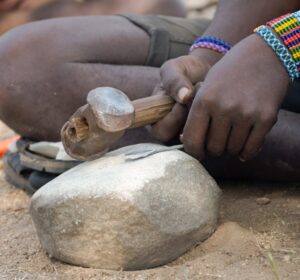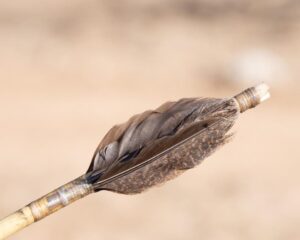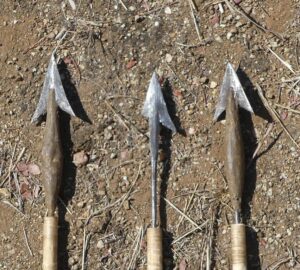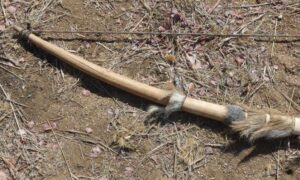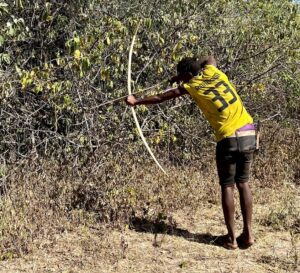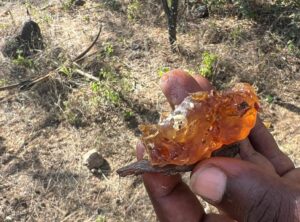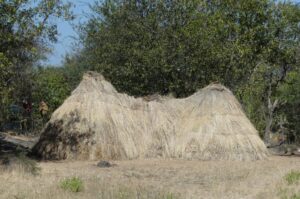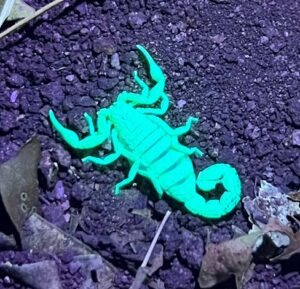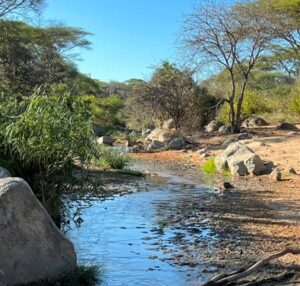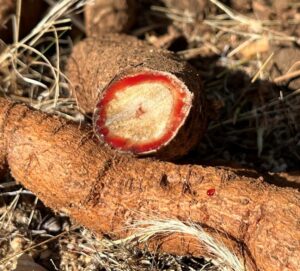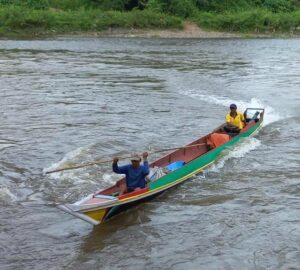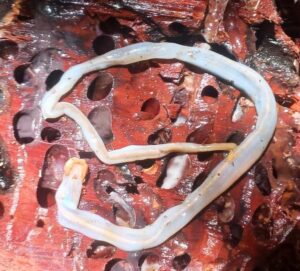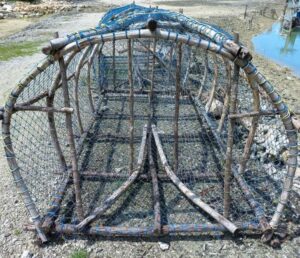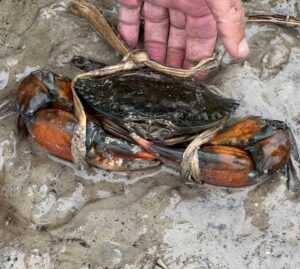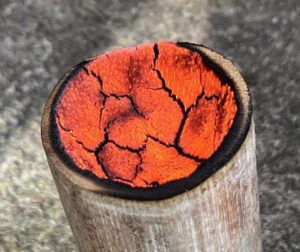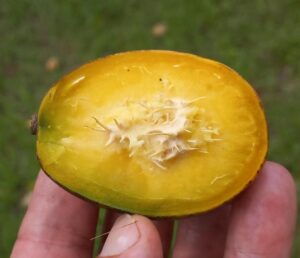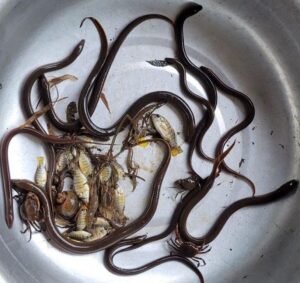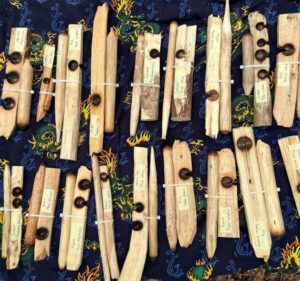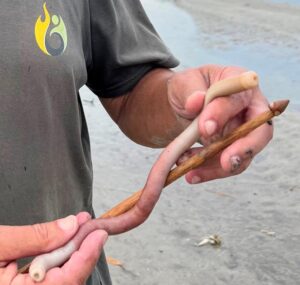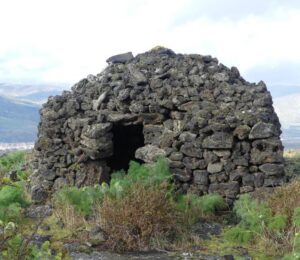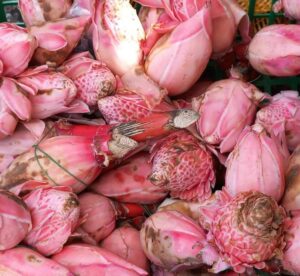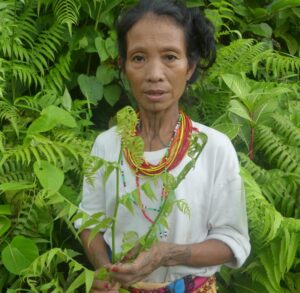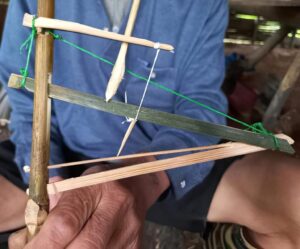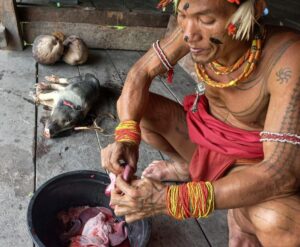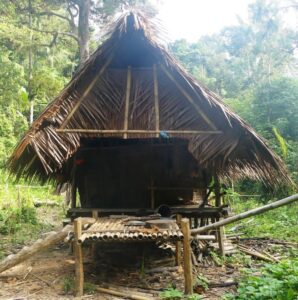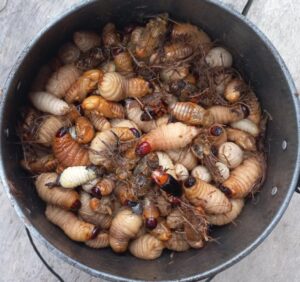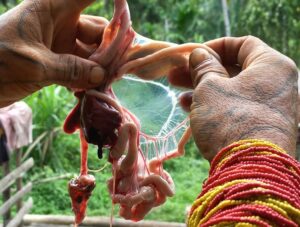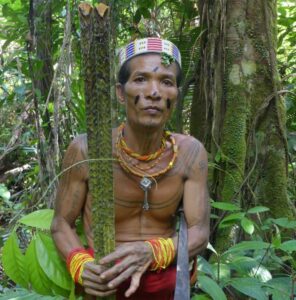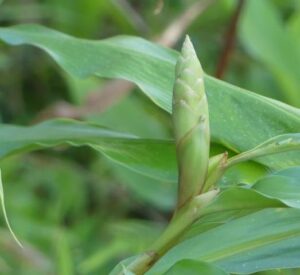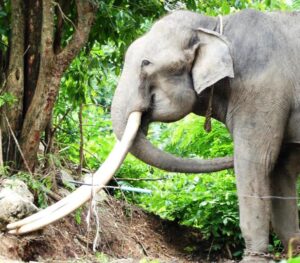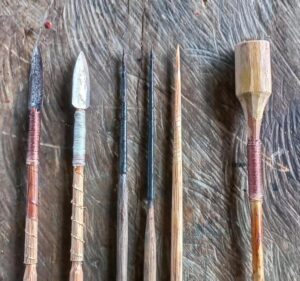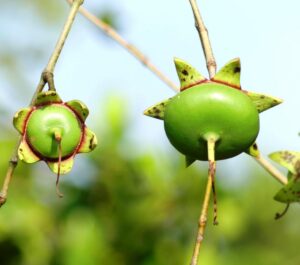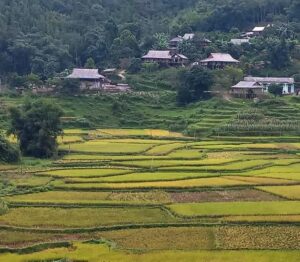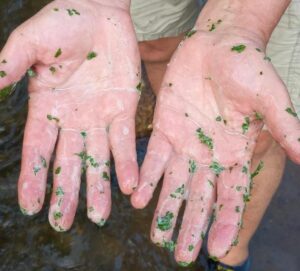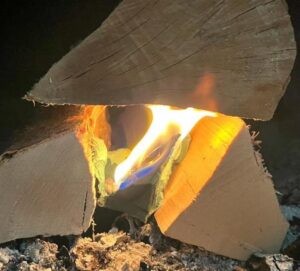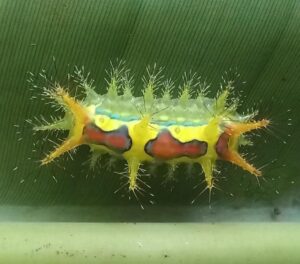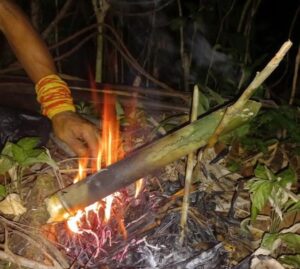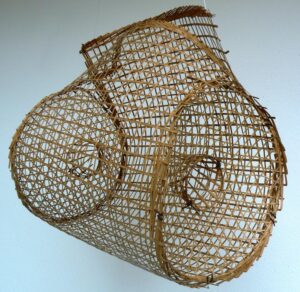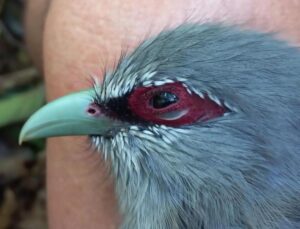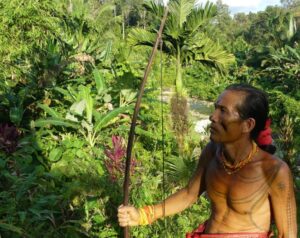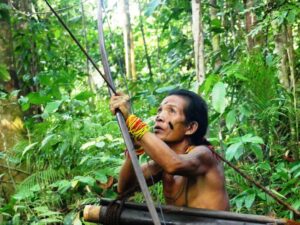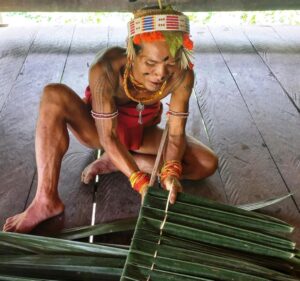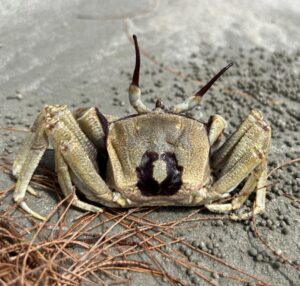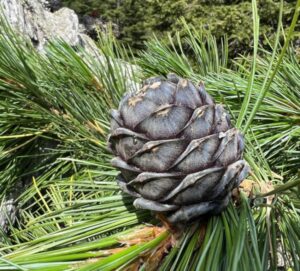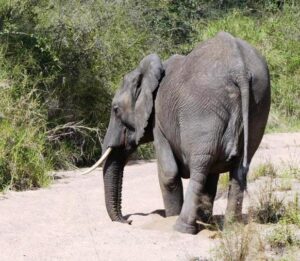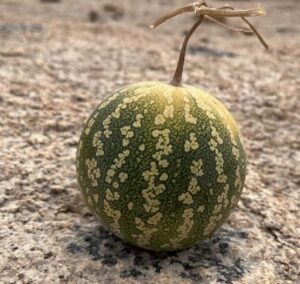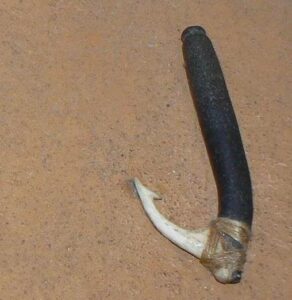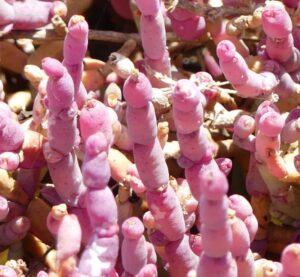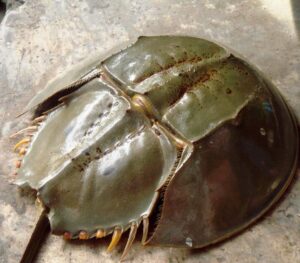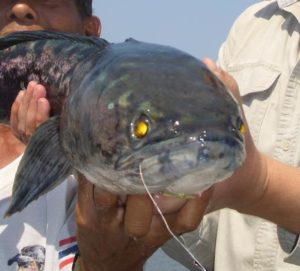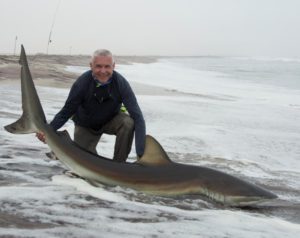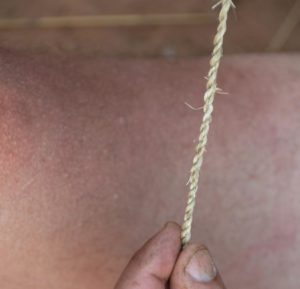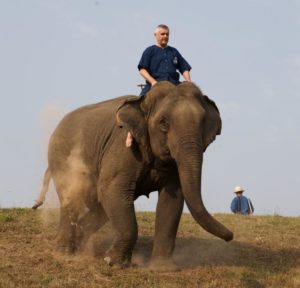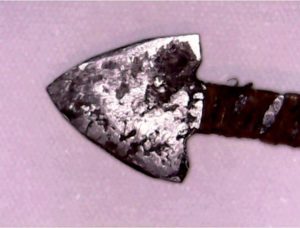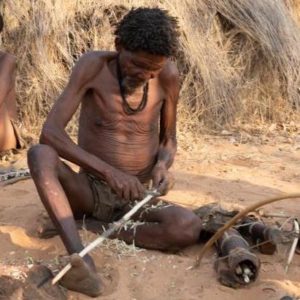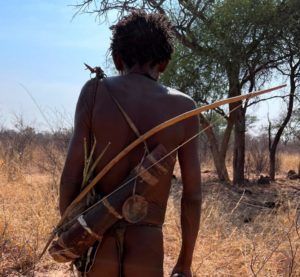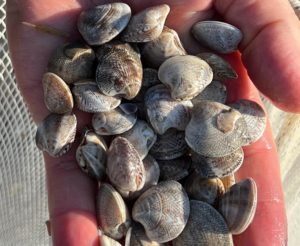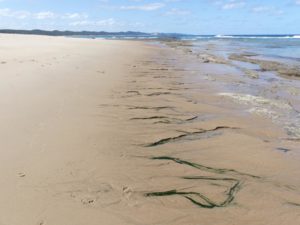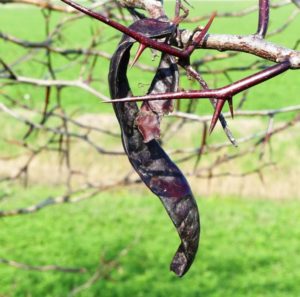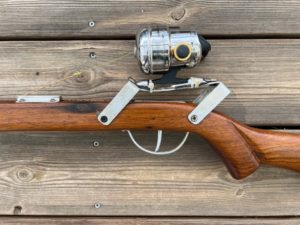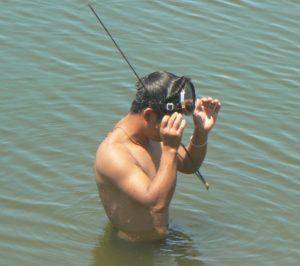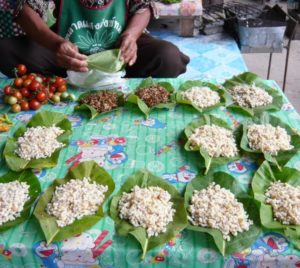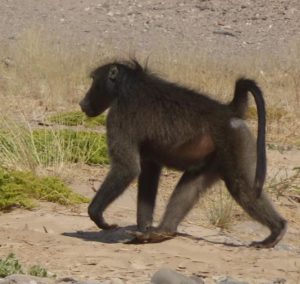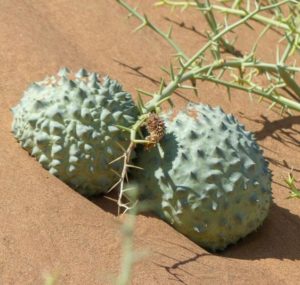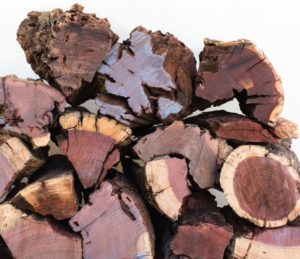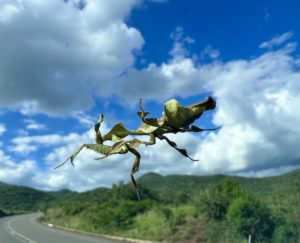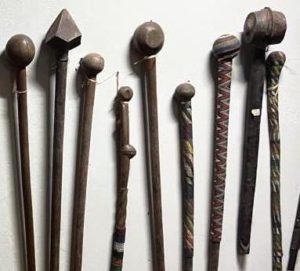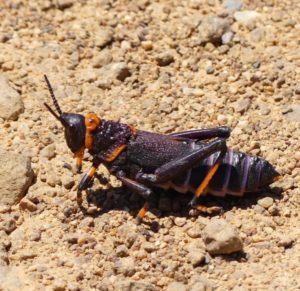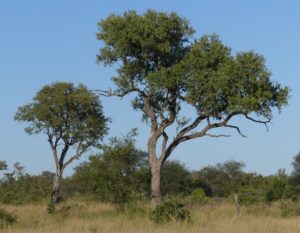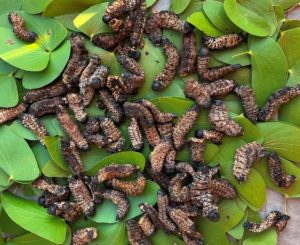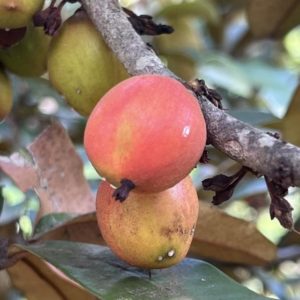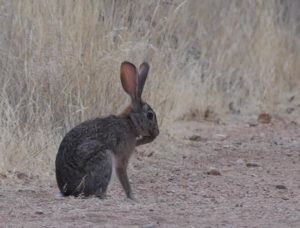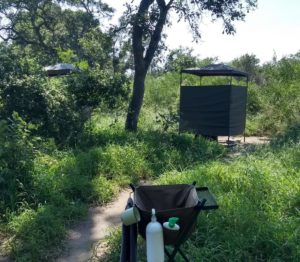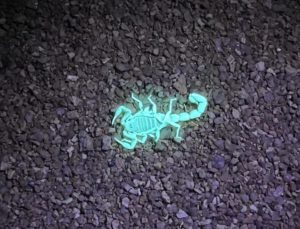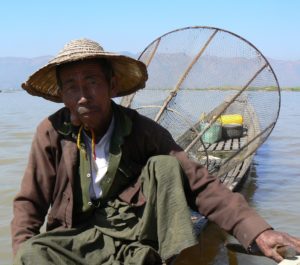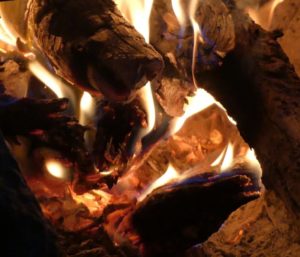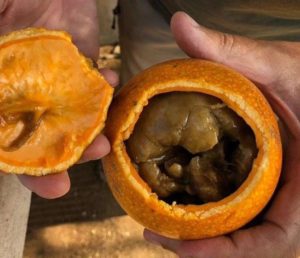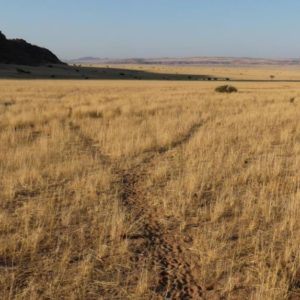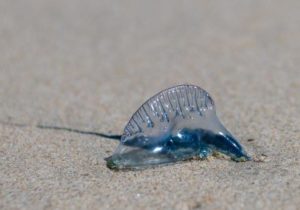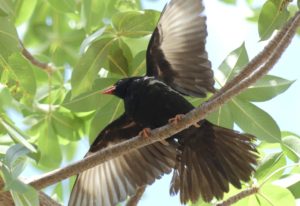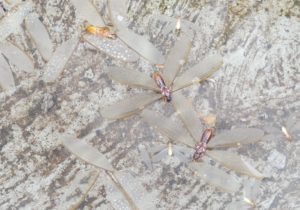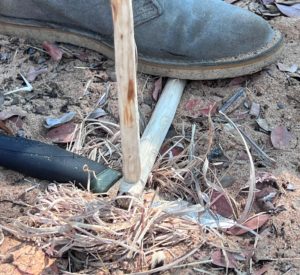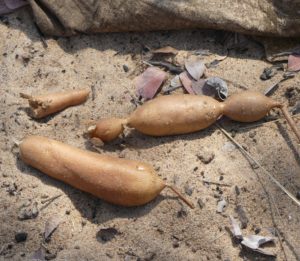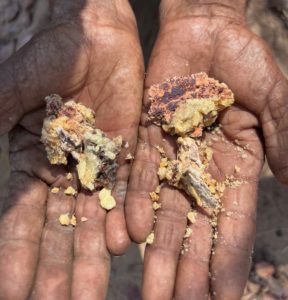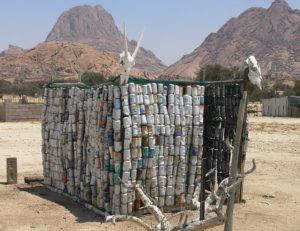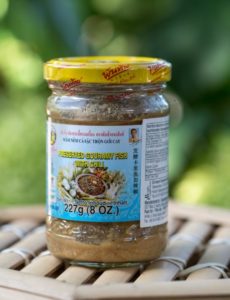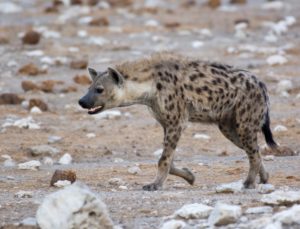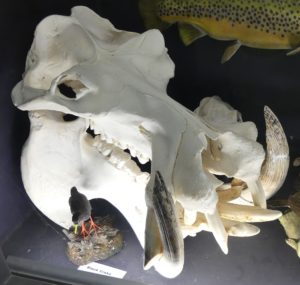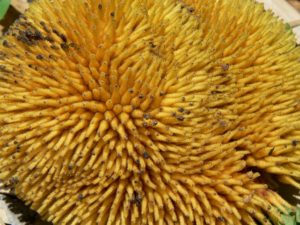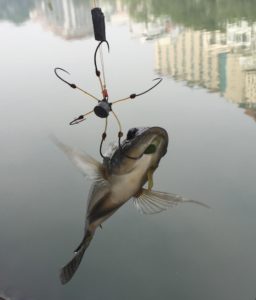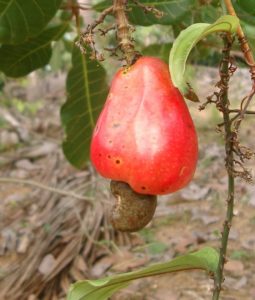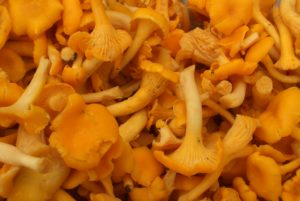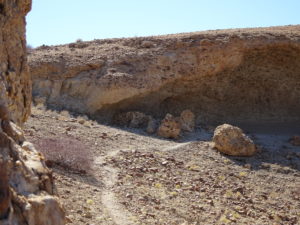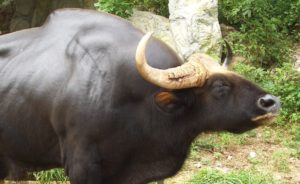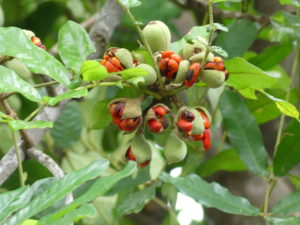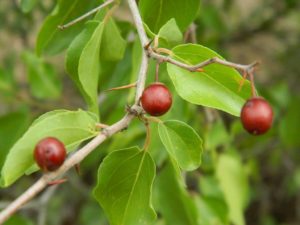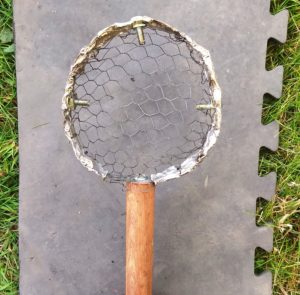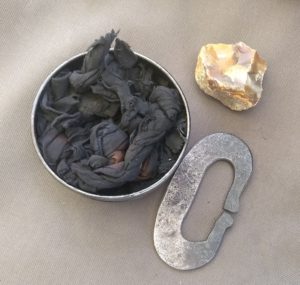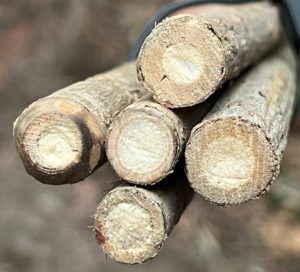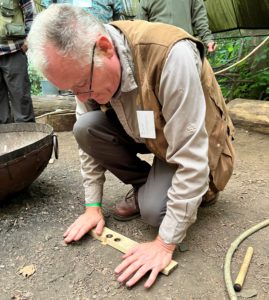Kurt Hoelzl
Fruits eaten by Mentawai people
The fruits eaten by Mentawai people in the forests are various species of bananas, coconuts, durians, and fruits from the rattan palm. Other fruits are also harvested, of which some grow wild, while others are planted and cultivated. Fruits are…
Vegetables eaten by Mentawai people
Cassava (Manihot utilissima) leaves and Fiddlehead ferns are the most essential vegetables for the Mentawai people living in the forests of Siberut Island. Both vegetables were discussed in separate articles on this webpage. Details about Cassava leaves can be found…
Freshwater fishing at Siberut Island
Depending on the location of the longhouse of a Mentawai family, fishing is conducted in any permanent water structure large enough to hold fish, gastropods, or crustaceans. In general, fishing is regarded as the work of men; women fish only…
Carbohydrate food sources of Mentawai
Three of the four most essential food plants for Mentawai people on Siberut Island in Indonesia are carbohydrate sources. Notably, sago is a key provider, with an average composition of approximately 94% carbohydrates, about 7% moisture, and negligible other components….
Snakes on Siberut Island
Bites from venomous snake species appear to be the highest concern when walking in the Siberut forests. There are anecdotal reports that middle-aged Mentawai men were bitten by pit vipers three or four times in their lives. Non-Venomous Snakes (Harmless…
Shrimp pit traps on Sri Lanka’s east coast
Fish, crabs, and shrimp provide the livelihood of small-scale and artisanal fishermen on the east coast of Sri Lanka. Due to specific local conditions, various fishing and gathering techniques have evolved, including the use of shrimp pit traps. Tidal situation…
Gathering of Venus clams by finger probing
Venus clams (Meretrix meretrix), correctly named ‘Asiatic hard clams’, are one of Thailand’s most sought-after clams for food. They occur both in the Gulf of Thailand and on the coasts of the Andaman Sea. Fully grown species are large; their…
Vedda flint & steel fire making
Village and Rock Veddas have used flint and steel to produce fires since the end of the 19th century. My former article about Vedda fire drills explains these two different Vedda types. Village Veddas have used this fire-making procedure since…
Vedda fire drills
Until the end of the 19th century, the Vedda people in Sri Lanka used fire drills as their standard fire-making method. In the literature of that time, Vedda was spelled Veddah, and Sri Lanka was called Ceylon. Current situation of…
Beach huts of Zanzibar
Traditionally, the beach huts of Zanzibar are often simple thatched structures made from coconut palm leaves, mangrove poles, and coral stone. Initially, they served as a storage place and shelter for fishermen, who needed them to repair nets, store fishing…
Feral donkey trails leading to water
At the end of the 19th and beginning of the 20th centuries, many draught animals were released in the wild in Western Australia, as motor vehicles took over their work. These included donkeys and camels. Both species flourished thereafter in…
Hadzabe footwear
Hadzabe people use footwear to protect their feet in their living areas. They need adequate foot protection against thorns, sharp plant blades, and edgy stones, as well as against the heat on sand and rock surfaces. In former times, they…
Smoked oysters from the rocks
In the spring of 2025, I traveled to Western Australia to document local survival techniques used by Indigenous people. Across Australia, Indigenous groups are generally categorized into three main types: the so-called ‘Saltwater mobs,’ who live along the coast; the…
Collecting sea urchins in the lagoons
The Collector urchins (Tripneustes gratilla) are a sea urchin species around Zanzibar. Its gonads, which contain either the roe (females) or milk (males), are a delicacy. This sea urchin species is harvested in the hot months of the year, and…
White-spotted hermit crabs
While beachcombing in the lagoons of Zanzibar, we found a White-spotted hermit crab (Dardanus megistos) housing itself in a Fusinus sp. shell. These crabs are exceptionally beautiful, and I therefore want to present them in this article. Description of White-spotted…
Black Lollyfish for food
The Black Lollyfish (Holothuria atra), the Black sea cucumber, is found primarily in the Indo-Pacific region and Zanzibar. It has a distinct cylindrical body, typically black or dark brown in color, with a smooth, leathery texture. It is commonly covered…
Wild sandfish sea cucumbers
Sandfish sea cucumbers (Holothuria scabra) are the most valued species in many tropical coastal regions, particularly Asia. This is based on their use in traditional medicine and as a delicacy. Overexploitation has led to population declines in some areas, prompting…
Freshwater springs in the lagoons
Freshwater springs in the lagoons of Zanzibar are a unique feature of this island. Although such springs exist on many – or even most – coasts worldwide, these Zanzibarian springs can be used as a characteristic example of this phenomenon….
Coastal foraging at Zanzibar
Coastal foraging and fishing are the foremost traditional activities people do on the coasts of Zanzibar. These activities are not restricted to this island or country but everywhere worldwide with a suitable coast. In English, coastal foragers are also called…
Ngalawa boats
Ngalawa boats are extended log boats with double outriggers and lateen sails used by artisanal fishers on the East African coast. They are between 4 and 9 meters long, but most of them are somewhere in the middle between these…
Spearing of African blue swimming crabs
Africanan blue swimming crabs (Portunus segnis) are speared by beachcombers in the lagoons of Zanzibar. These crabs, however, are not the prime target when spearing but only an opportunistic by-catch. The prime target when using spears for fishing is octopuses….
Conch collection for food
Humpbacked conch shells (Gibberulus gibberulus) are true conchs based on the type species Strombus gibberulus. In Swahili, they are called Chuale and are primarily collected by women, who use them for their family’s subsistence and cash income. They are harvested…
Basket fish traps at the seashores of Eastern Africa
Large basket fish traps, with a hexagonal shape and one inverted end, are typically used in Zanzibar and are called ‘Dema’ in Swahili. These fish traps, which have a large mesh size, were initially made from palm leaves and mangrove…
Fruits eaten by Hadzabe people
Besides honey, meat, Baobab fruits, and tubers, berries are one of the significant food classes that the Hadzabe people eat. Honey is the most important one for both Hadzabe males and females. However, females relish berries as the second most…
Sea hare without caviar
Sea slugs of the taxonomic family Aplysiidae are commonly called ‘sea hares’, because when underwater, their rounded body shape and the long rhinophores on their heads resemble that of a sitting rabbit or hare. Unlike other sea slugs (nudibranchs), they…
Catching octopuses in the lagoons
Catching octopuses in the lagoons of Zanzibar is an age-old and sustainable activity mainly carried out by adult women. Depending on the number of caught animals, they are used to feed the family and sold to restaurants and fishmongers. As…
Water disinfection by UV-rays from the sun
One method of disinfecting water from biological hazards is utilizing UV rays from the sun, known as SODIS (Solar Disinfection). The principle of water disinfection by solar radiation was first discovered in 1984 by Prof. Aftim Acra of the American…
Sea lettuce for salad
Sea lettuce (Ulva lactuca) is common on most shorelines worldwide. This article focuses on the island of Zanzibar in Tanzania. There, sea lettuce is used as an export article and supplementary food for humans. In addition to being collected in…
Edible red seaweed on Zanzibar beaches
In Zanzibar, two edible red seaweed species are commonly used for food: Spinosum and Cottonii, also called ‘Elkhorn sea moss.’ Both species can be found wild in the coastal area and are also farmed intensively. In addition to these two…
Bamboo rat for dinner
Bamboo rats are a common rodent in bamboo thickets in mountainous areas of northern Vietnam. Hmong tribal people in remote regions still hunt them regularly for food. Although hunting bamboo rats is officially prohibited, the practice is still widespread. To…
Creating fire with a magnifying glass
A magnifying glass has been used to start fires since ancient times. Greek and Roman writers recorded the use of ‘Burning glasses’ for domestic and war purposes. A concise history of these applications can be found on Wikipedia. Nowadays, fires…
White truffle hunting in Istria/Croatia
White truffles (Tuber magnatum) are the most highly-priced truffle species. In total, six different truffle species occur on the Istra peninsular. Four of them are variations of Black truffles (T. aestivum, T. aestivum var. uncinatum, T. melanosporum, T. brumale), and…
An oyster species growing on Mangrove trees
Mangrove oysters (Isognomon ephippium) are the species most commonly found growing on mangrove trees in Northern Australia. Its other common English name is ‘Saddle tree oyster.’ These oysters are one species eagerly collected and eaten by Bardi people at the…
Long-spine Porcupinefish on the coast of Zanzibar
The Long-spine porcupinefish (Diodon holocanthus) is one of the many seafood organisms local people catch or collect at low tide in shallow waters around Zanzibar island. This fish is not specifically searched for, but it will be happily speared and…
Datoga spears
These spears have a long history but were replaced for hunting by bows and arrows in modern times. Nowadays, their primary purpose is personal protection against predators when traveling on foot for longer distances. The author encountered a couple of…
Datoga huts
The Datoga are pastoralist people living in various regions of northern Tanzania. Their estimated population is about 30,000. One of their main settlement areas is on the eastern shore of Lake Eyasi. Datoga settlement areas consistently face pressure from the…
Bow hunting equipment of the Datoga tribe
Datoga people are spread over a wide area on the Masai steppe in Northern Tanzania. Their main stronghold is around Lake Eyasi. There, especially in the Yaeda Valley, they live close to the Hadzabe people. Masais pressed Datogas into less…
Hadzabe Axes
Hadzabe axes are part of the standard outfit of every Hadzabe man living in remote areas. This outfit consists of his bow, a bunch of arrows of various types, a firestick, his knife, and the axe. Additionally, he will carry…
Hadza hand drill friction fire
Hadza hand drill friction fires are the standard fire-making method of the Hadzabe people in Tanzania, who live remotely. They do not have the omnipresent butane gas firelighters of the modern world or any other artificial methods. Even when lighting…
Hadza Arrow Poison – Strophanthus and Acokanthera species
Arrow poison based on Adenium sp. plant extracts was covered in a former article on this website. In the following, we will discuss the second type of poison the Hadzabe people make, which they call Shanjoko, a Strophanthus species. Additionally,…
Hadza Arrow Poison made from Adenium species
Remotely living Hadzabe people use three types of arrow poison to bag big game animals. However, due to the shrinkage in the size of their areas, they currently produce only two kinds. I will describe these arrow poisons briefly to…
Hadza style of shooting bows
Shooting bows by remotely living Hadza boys and men is a daily, necessary affair. From the age of three, they start shooting bent sticks. As youngsters, they are soon required to contribute meat to the family. Through this early and…
Cold-forging of iron arrowheads
The Hadza people, who live in remote areas, produce iron arrowheads themselves. Contrary to what is often mentioned in the literature, they do not buy these iron arrowheads from the Datoga people. Both tribes used different production methods. Whereas the…
Hadzabe arrow shafts and fletchings
Arrow shafts are a piece of Hadza men’s identity. Remotely living Hadza men always carry their bows, arrows, and firesticks. Whenever they have leisure time, they attend to their arrows by building new ones, checking and correcting their straightness, or…
Types of Hadzabe Arrowheads
Hadzabe people use four basic arrowhead types, which are further divided into different styles. All of these types and styles serve specific hunting applications. 1st basic type of Hadzabe arrowheads: Wooden arrow tips These types of arrowheads are called hik’o…
Hadza bows for hunting
Hadza bows are not only used for hunting but are also ubiquitous adornments for nearly all Hadza men. They even carry their bows, arrows, and firesticks around when they are not going to hunt. The bows are often short-lived and…
Hadza hunting techniques
Hadza people in remote areas of Tanzania are one of the last remaining hunter-gatherer tribes in Africa. However, only about 25% of Hadza people live this original hunter-gatherer life. That means, from a total population of about 1300 Hadzabe in…
Baobab seeds and pulp porridge
Baobab seeds and vine roots are staple foods for remotely living Hadza in Tanzania. This article already presented the collection and preparation of vine roots. In the following, we will discuss how to prepare Baobab seeds and their surrounding dry…
Sweat Bees – not a danger, but a nuisance
Correctly named Sweat Bees are Halictid Bees, an extensive and diverse family of bees. These small—to medium-sized bees are often the most common flower visitors and essential pollinators. About one-third of all bee species in East Africa are halictids. However,…
Stingless bee honey collected by Hadza people
The Hadzabe people eagerly collect stingless bee honey all year long. They do this destructively by cutting open the hives in tree hollows, and both honey and brood are harvested and eaten. Foraging on these insects has not significantly affected…
Traditional Hadza camps and huts
Traditional Hadza camps are loose affiliations of relatives, in-laws, and friends. Each camp has a few core members, but most others come and go as they please. If there are conflicts, the feuding parties will resolve them by simply separating…
Hottentotta trilineatus scorpions at Yaeda South in Tanzania
We found Hottentotta trilineatus scorpions when camping on a rocky ridge in the Yaeda South area. The place where we put up our tent was about 2 km / 1.2 miles from the next Hadza camp and in the middle…
Hadza water sources
The Hadzabe (plural of Hadza) natural environments are the escarpments and rocky, wooded hills that form the watersheds for Lake Eyasi and Yaeda Swamp in Tanzania. In this Rift Valley environment, seasonal rainfall changes and surface water availability from runoff…
Climbing a Baobab tree
A Baobab tree (Adansonia digitata) is characteristic of African Savannah biomes. In Tanzania, the Hadza people in the mountainous southern area of Lake Eyasi taught us to climb these trees. Although it is not difficult, knowing the techniques for a…
Wild Sweetpea tubers as food for Hadza people
Wild Sweetpea (Vigna frutescens) tubers are a staple source of starchy food for the Hadza people in Tanzania. The plant’s common name in the Hadza language is //ekwa. To collect them, groups of Hadza women regularly head out into the…
Orang Rimba shelters in the forests of Sumatra
Orang Rimba (locally called Kubu) shelters and dwellings in the forests are designed in different styles rooted in their semi-nomadic lifestyle. These structures can be divided into two main groups: semi-permanent structures and shelters when they are on the move….
Visiting Orang Rimba people in Jambi province
Who are the Orang Rimba people? The expression ‘Orang Rimba’ means ‘People of the rainforest,’ but this name is primarily used by scientists internationally. In Indonesia, the people call them ‘Kubus,’ which means being outside or on the fringe of…
Collecting honey in a rock crevice
Asian honey bees and their combs are a special treat for the local population of backcountry areas at Pu Luong Nature Reserve in northern Vietnam. The harvested honey is seldom sold and is mainly used by the villagers. The grubs,…
Harvesting Shipworms in a Thai Mangrove Forest
Edible shipworms, in this case Bactronophorus thoracites, are also known as Naked clams, Priyang talay (เพรียงทะเล), and various other common names throughout the region where they occur. They bore into wood immersed in salt water and are a major hassle…
Disinfecting water with Potassium Permanganate
Potassium permanganate is an essential chemical for various simple living applications. One is its disinfecting effects, and the other is the possibility of chemically starting fires. This article discusses disinfecting water on a small scale for drinking purposes. We will…
Collecting Pipi clams at Rawai Beach
Pipi clams (Donax deltoides) are also known as Surf clams, Sandy Donax, and a wide range of other common names. In Thailand, they can be found on most beaches in the Gulf of Thailand and the Andaman Sea. They are…
Bottom fish traps of the Urak Lawoi people
The following information was gathered from a Urak Lawoi man who has lived in the Rawai Beach Sea-Gypsy Village for 27 years. He was 57 years old and only had one tooth (incisor) left in the middle of his upper…
Rectangular squid traps in Thailand
Rectangular squid traps are used in the Gulf of Thailand and along the coastline of the Andaman Sea in the same way as semi-circular traps. Both types are used mainly for catching Bigfin reef squid (Sepioteuthis lessoniana) but will also…
Catching mud crabs at Koh Lanta
Mud crabs are common in mangrove areas in Thailand. They are primarily caught in crab pots for commercial purposes. However, my Urak Lawoi friends and I specialized in digging up and catching these crabs by hand. Who are Urak Lawoi…
Giant Fennel pith for transporting fire
While researching various bushcraft and survival topics, I constantly encounter inconsistencies and errors on reputable websites. Therefore, I have gotten into the habit of checking many postulates myself. One of these statements is that Prometheus brought fire to Earth with…
Red-tailed pipe snake
The ‘Red-tailed pipe snake’ (Cylindrophis ruffus) was recently renamed ‘Jodi’s pipe snake’ (Cylindrophis jodiae), which we are talking about here. It is called a ‘Pipe snake’ because it has a round, pipe-like body. The lower end of the body can…
Ambarella fruit in the Mekong Delta
Ambarella fruit (Spondias dulcis Parkinson; syn.: Spondias cytherea) is native to Melanesia and Polynesia and was introduced worldwide throughout the tropics. Its other common English names are Jew plum and Golden apple. In the Mekong Delta, it is omnipresent in…
Trapping eels in Northern Vietnam
Trapping eels is a simple way for rice farmers in the catchment area of the Red River in North Vietnam to provide themselves with animal protein. No special skills are required, as with angling or net fishing. The activity is…
Advanced Rifle Handling (ARH) for Trail Guides
Hikes through natural areas in Southern Africa where dangerous game is present must be conducted with at least one, but usually two, armed trail guides. One is the “Lead Guide” or “1st Rifle,” and the second is called the “Back-up…
Bow Drilling – following the method of Mattias Norberg
At the Global Bushcraft Symposium 2022 in Wales/UK, the Swede Mattias Norberg demonstrated his method of creating fire by bow drilling. Sweden has a rich outdoor tradition, and it was a privilege to meet him there, as he has deep…
Giant Fennel stalks for lighting fire
Various internet pages and YouTube channels describe lighting fire with stalks of giant fennel (Ferula communis) as easy. I doubted these claims, so I tested them myself. The outcome was sobering, which I will describe in the following article. I…
Giant Fennel stalk wood as building material
Giant Fennel (Ferula communis) is a common weed in Mediterranean countries and Central Asia. Except for one genetic variety in Sardina, all green parts of the plant are strongly haemotoxic and lead to the poisoning of livestock and humans. This…
Edible rock snails in limestone areas of Vietnam
Rock snails of the genus Cyclophorus are highly sought-after wild foods in rocky limestone mountain areas of Vietnam. These snails are not only regarded as food but also as medicine against various ailments. The local Vietnamese name is Ốc thuốc,…
Blowpipe hunting with Orang Asli people in Malaysia
Blowpipe hunting is still prevalent in many Orang Asli communities in Malaysia. Although the government strictly enforces hunting rules and regulations, it is practically impossible to supervise all the remote small hamlets and villages. On the other hand, it is…
Collecting Bibi worms on Koh Lanta
Bibi worms (Sipunculus nudus Linnaeus, 1776) belong to the Peanut worm phylum. They can be dug up at the intertidal zone of flat, sandy beaches on temperate and tropical beaches. These worms are primarily used as top fishing bait. At…
Wild asparagus in Sicily
Wild asparagus, a unique culinary delight, is prominent in Sicily’s springtime cuisine. The region boasts two distinct species: Asparagus albus, White asparagus, and Asparagus acutifolius, affectionately dubbed ‘Wild asparagus’ in English. Another edible part of these plants is its ‘crown’…
Stone huts at Mount Etna in Sicily
Stone huts on the northern side of Mount Etna in Sicily were built at least since pre-Hellenic times, around 4,000 BC. The building materials were basalt blocks from eroded lava at this location. The builders used dry-stone wall construction without…
Ginger flowers add zest to food
Ginger flowers are eaten in many Southeast-Asian cultures. In Indonesia, most ginger varieties are known from Siberut Island. The native population of this island has utilized the flowers of Torch Ginger (Etlingera elatior (Jack) R.M. Sm.) since ancient times for…
Young Cassava Leaves provide protein and micronutrients
Young cassava leaves are a regularly eaten side dish for Mentawai people. Cassava (Manihot esculenta, Crantz) is endemic to the southern rim of Amazonia in South America. There, it was domesticated around 5000 BC. In the 16th century AC, Spanish…
Vegetable ferns are a source of nutrients in Siberut
Vegetable ferns (Diplazium esculentum (Retz.)) are among the few wild vegetables Mentawai people in the forests eat regularly on Siberut Island. By Mentawais, they are called ‘Laipat.’ Other wild vegetables are cassava leaves, ginger flowers, taro stalks, and wild eggplants….
Scissor Traps of Thái Đen tribals in Vietnam
Scissor traps are universal traps that can catch all kinds of small rodents. They are easy to produce from bamboo but need one item to be sourced in the villages. These are strips of bicycle tubes, which are not easy…
Bow Traps of Thái Đen tribals in Vietnam
Bow traps are used by Black Thai tribal people in Northern Vietnam to catch small rodents. These ingenious devices are carved from pieces of bamboo and some strings. The closing force of the scissor comes from a bow-like structure above…
Domestic pigs as food by Mentawais
Domestic pigs are a typical gift from a Mentawai family to a shaman for his support or services. In our case, Aman Aru attended a ceremony in a neighboring Uma (family home in the forests), which had to be cleaned…
Deadfall Traps of Thái Đen tribals in Vietnam
Deadfall traps with a Figure-4 trigger are essential knowledge for survivalists and bushcrafters worldwide. Thái Đen (Black Thai) tribal people at Pù Luông Nature Reserve in Northern Vietnam use these traps and the Figure-4 trigger in a modified version. Modifications…
Mentawai forest huts
The Mentawai people at Siberut Island use forest huts (called Sapou by them) for various reasons and purposes. One is a permanent dwelling for single, old men who do not live with their family in the Uma (family home in…
Rattan fruits in Siberut jungles
Rattan fruits are available throughout the year in all Southeast Asian rainforests. There are about 600 different species of rattans, and many of them bear edible fruits. However, rattan prickles are a common nuisance when walking in the jungle. Nevertheless,…
Carrying baskets of Mentawai people
Two types of carrying baskets were used during my stay with the Mentawai people at Buttui on Siberut Island. One, locally called Opa, was fully enclosed on the sides and had an open rattan bottom. The other type was entirely…
Cutting tools at Siberut Island
The cutting tools of Mentawai people living in the forests are adzes, axes, machetes, and one specialized knife. All these tools have a solid historical background and are still used today. During my stay with a Mentawai family in December…
Sago worms of an unidentified species at Siberut Island
Sago worms are one of the food items that come naturally with the Mentawai’s staple food, sago flour. The worms grow in felled palm trunks or saplings. They are not worms but larvae and pupae of the Palm Weevil beetles…
Chicken as food by Mentawais
Domestic chickens are omnipresent around every Uma (family home) in the forests of Siberut Island. During nighttime, they are kept in closed coops to protect them from predators like civet cats. While staying with Mentawais, I observed no nesting boxes…
Rattan leaf stalks for coconut grating
Rattan leaf stalks have been, since immortal times, the tools with which Mentawai people have been grating coconuts. These long-lasting tools grate the coconuts into the required size of flakes. When worn out or broken, a new one will be…
Taro – another staple food of the Mentawai people
Taro (Colocasia esculenta (L.) Schott) is one of the three staple food items of the Mentawai people on Siberut Island in Indonesia. The other two are sago and bananas. In many other countries, taro leaves and corms are eaten. Mentawais…
Roasted Sago sticks on Siberut Island
Roasted sago starch is the staple food for Mentawai people living in the moist, tropical forests of Siberut Island, off the coast of Western Sumatra in Indonesia. On the other hand, sago, boiled to porridge, is eaten as a staple…
White Ginger Lily for cleaning hands
White Ginger Lily (Hedychium coronarium J. Koenig) belongs to the Zingiberaceae (Ginger) botanical family. Mentawai people use the crushed stem to clean their hands after touching arrow poison or one of its two poisonous main constituents. In another article on…
Danger of Asian elephants – whether they are in musth or not
Asian elephants (Elaphas maximus) are smaller than their African cousins but not less dangerous when in musth. That danger was already described for African elephants in this article on this website. In the following, we briefly compare the differences between…
Mentawai arrow poison
The Mentawai people use poison on their arrows to hunt game. In previous articles on this website, we discussed the Mentawai people’s hunting methods. Then, we presented an actual hunt for Flying foxes. We then discussed the longbows used on…
Hunting arrows and quivers of the Mentawai people
Bows and arrows are the primary hunting weapons used by the Mentawai people. Their bows were already described here. This article will explain the different types of arrows used for these bows and give an insight into the quivers used….
Mangrove apples at the Mekong Delta
Mangrove apples are the fruits of Sonneratia sp. trees, one of the important genera of trees in the Mangrove forests of Southeast Asia. All species of Sonneratia will develop edible Mangrove apples. The various Sonneratia species differ slightly in shape,…
Animal species collected by rice farmers in the Red River Delta
Rice farmers in secluded areas of the Red River Delta in Northern Vietnam need dietary additions to their staple rice dishes. Vegetables are harvested from around their homes and surrounding tropical Evergreen forests. Animal proteins are mainly collected in and…
Natural shampoo from a Soap plant (Gouania leptostachya)
Natural shampoo can be extracted from a variety of plants worldwide. In the evergreen forests of Lowland in Northern Vietnam, we used the leaves of a so-called soap plant. With these leaves, we regularly washed our hands and bodies. In…
Egg carton fire starters
Fire starters are convenient aids in Austria’s cold winters. Wood shavings lighted wood- and coal-burning stoves one generation ago. These shavings lighted spruce kindling, which in turn started burning bigger pieces of wood. Nowadays, it’s easier. Either commercially available or…
Building a specialized fishing boat at Padang
In Indonesia, there is a wide variety of traditional fishing boat designs. Most of them are variations of standard types adapted to local needs and conditions, and many of them have not been systematically described yet. This article presents one…
Stinging Nettle Slug Caterpillar in Vietnam
When hiking in Pu Luong Nature Reserve in northern Vietnam, we found a species of Stinging Nettle Slug Caterpillar on a Banana leaf. My local friends got highly nervous when they saw it, and I was intensely warned against touching…
Boiling water in bamboo
Boiling water in green bamboo stems (‘culms’ would be the botanically correct term) is not a significant skill, but it represents the basic cooking technique in Southeast Asian forests. One of the following articles will build on that and explain…
Trapping Snakeskin Gourami in the Mekong Delta
Trapping Snakeskin Gourami fish (Trichopodus pectoralis) is commonly done all over Southeast Asia. However, a specific trap for catching them was developed in the Mekong Delta in Vietnam. Its simple principle could be easily applied to many other areas of…
Green-billed Malkoha bird on the spit
The Green-billed Malkoha is a common bird in Vietnam’s semi-deciduous tropical forests. An expedition led to the capture of one who was cooked for lunch. This and other species are often hunted by villagers supplementing their diet with this and…
Catching Octopuses by Sea-Gypsies
Sea-Gypsies – Urak Lawoi, Moklen, and Moken – traditionally catch octopuses along the Andaman Sea’s rocky shores. Using a metal skewer and baited bamboo stick, they locate octopuses in holes with foam or clean pebbles. Patiently baiting them, they impale…
Mentawai Hunting bows
Hunting bows are the primary hunting weapon for the Mentawai people and are very personal items for a hunter. They have excellent skills in using them and practice shooting from childhood onwards. During my stay with the Mentawais, I looked…
Flying fox hunting
Flying fox hunting remains a prevalent activity in Indonesia, particularly in Sumatra. Aceh, the northernmost province, is the epicenter of the trade in Flying fox meat. Locals believe that this meat possesses qualities to alleviate asthma, although this claim lacks…
Hunting methods of Mentawai people
The hunting methods of the Mentawai people have developed over about 3000 years. Their ancestors were of a Mongolian race that migrated from Taiwan via the Philippines to modern-day Indonesia. They arrived around 1000 BC at Siberut island in West…
How Mentawai people assemble roof thatching panels
Roof thatching is vital for shelter waterproofing in the Mentawai tribe, which has around 6,000 members, on Siberut Island, Indonesia. Siberut lies about 100 miles (160 km) west of Padang in West Sumatra. Of the 6,000 Mentawai people, roughly 1,000,…
Catching Ghost crabs by digging
Ghost crabs (genus Ocypode) comprise 22 different species, and they are commonly also called `Sand crabs.` The scientific name Ocypode has Greek origin and means swift-footed. Ghost crabs are semi-terrestrial crabs that dig deep burrows in intertidal zones of sand. They…
Swiss pine cones and their uses
The Swiss pine (Pinus cembra) goes by different names in German-speaking countries, such as ‘Zirbe,’ ‘Arve,’ ‘Arolla pine,’ or ‘Austrian stone pine.’ For generations, people have used the nuts of this particular pine species as food during the winter months,…
Bushmeat snaring
Bushmeat snaring is a widespread hunting method in Sub-Saharan Africa. Public landscapes in this part of the world are often devoid of larger wild animals due to bushmeat hunting. This is so bad in some places that mammals – even…
Elephant diggings in dry riverbeds
African elephants (Loxodonta africana) require approximately 40 to 60 gallons (150 to 220 liters) of water daily to maintain their health. They obtain this water from various sources, including open water bodies and wells dug in sandy riverbeds. Additionally, elephants…
Use of Tsamma melons in Namibia
Tsamma melons are the original progenitors of watermelons. Historical records indicate that these melons were already under cultivation in the Nile Valley as far back as 2000 BC. In contemporary times, Tsamma melons continue to be utilized for their oil…
Neolithic fishhooks in Korea
During the Neolithic Age (8000 BCE—1400 BCE), people across various regions began to adapt to the evolving natural environment following the Ice Age. This era is characterized by the emergence of earthenware artifacts and groundstone tools and the establishment of…
Seekoraal plants in Southern Africa
Seekoraal is the Afrikaans term for the Salicornia natalensis plant, which belonged to the Sacocornia taxonomic genus before being reclassified under the Salicornia genus in 2017. Salicornia plants are succulent, halophytic (salt-tolerant) flowering plants in the Amaranthaceae family. They thrive…
Utilizing Horseshoe Crabs as a Food Source
Foreword Horseshoe crabs are a species not protected in Thailand and are experiencing a significant decline. Their primary habitats, particularly the mudflats around mangrove forests, where they live and reproduce, are diminishing, and there is a growing demand for edible…
Using a stomping basket to catch fish in Vietnam
Fishing with a stomping basket has been a traditional craft in Vietnam for centuries. Postcards from the French colonial era depict this unique fishing method as a typical way for locals to catch fish. While similar techniques exist in other…
Giant Snakehead fishing in Thailand
The Giant Snakehead fish (Channa micropeltes) is a highly aggressive and predatory freshwater fish. Its diet mainly consists of smaller fish, frogs, crustaceans, and aquatic prey. In Malaysia, Singapore, and Indonesia, this fish is known as the ‘Toman’ and, along…
Shore fishing for Bronze Whaler Shark
Bronze Whaler Sharks (Carcharhinus brachyurus), also known as Copper Sharks, are sought-after game fish for recreational anglers in many parts of the world. They are known for their impressive strength and fighting abilities, which challenge anglers. These sharks can reach…
Catching Tigerfish at the Zambezi
Tigerfish hold a similar significance for Africans as the bass for Americans or carp for Europeans. These three fish species effectively represent the human populations on their respective continents. Tigers are my favorite, as they possess a remarkable blend of…
Making bow strings from plant fibers
The manufacture of bow strings from plant materials is a skill that Bushmen have practiced for a relatively short period. Around 1900, they learned from neighboring Bantu-speaking tribes how to use Sansevieria fibers to create bow strings. Before this, they…
Sweet ‘White Berry Bush’ fruits
Synonyms White Berry bush, Snowball bush (Eng.); Witbessiesbos (Afrikaans); Chinese waterberry (China), Goowal (Yawuru Australia); Flueggea virosa (Lat.) – Flügge was a German botanist, and virosa means poisonous or having a bad odor. Distribution Flueggea virosa commonly grows in deciduous…
Mahout training at Lampang province
The National Elephant Institute of the Forest Industry Organization of Thailand conducted mahout training for amateurs near Lampang. This institute was initially established as a training center for elephants working in the timber industry, where they learned how to lift,…
Composition of Bushmen Arrows
The topic of the composition of Khoi-san (Bushmen) arrows for hunting is vast and intricate. Numerous anthropological studies have documented the unique designs utilized by nearly every family group of Khoi-san in Southern Africa. These designs are often a result…
Making bushmen bows for hunting
Generally speaking, the Khoi-san (‘Bushmen’) employ bows and poisoned arrows for “tracking and stalking” during hunting in Northern Namibia and North-Western Botswana. The various Khoi-san tribes utilize different materials and techniques for crafting these weapons. However, in this article, we…
Eating centipedes in Yunnan Province, China
Eating insects and centipedes is a long tradition in Lijiang City, in Yunnan Province, P.R. China. In addition to centipedes, other insects such as bamboo worms, silkworm pupae, and locusts are also consumed. While they are high in protein and…
Bushmen hunting techniques in Namibia
In earlier times, the Ju//hoansi Khoi-san (Bushmen) of North-East Namibia employed four distinct traditional techniques for hunting animals. These techniques have remained unchanged, as even today (in 2023), the Ju//hoansi continue to eschew the use of firearms, sticking to their…
Sourplum fruits for food and oil
Sourplums, which belong to the Olacacea family, comprise two species: the Blue Sourplum (Ximenia americana) and the Great Sourplum (Ximenia caffra). Blue Sourplum The Blue Sourplum is naturally distributed in semi-tropical and tropical countries worldwide, as shown on the map….
Beachcombing for Vongole clams in Northern Italy
Vongole clams (Ruditapes philippinarum) are the main bivalve species collected from the flat beaches of the Adriatic Sea in Northern Italy. Introduced to aquaculture facilities in the lagoon of Venice in 1983, they are now considered an invasive species, having…
How to find freshwater on sandy beaches?
Freshwater seepages occur along drainage lines on beaches, where the water table meets the sea. These seepages are fed by freshwater supplies from inland, and the land beyond the sea is naturally higher than sea level, causing freshwater to flow…
Semi-Dried Fish in Thailand
In Thailand, both sea and freshwater fish are dried to increase their shelf life for later human consumption. Before the advent of refrigeration, the primary method for preventing spoilage was to salt the fish and then leave it in the…
Using Honey Locust Pods as Food
The Honey locust tree, also known as the Thorny locust, derives its genus name (Gleditsia) from a former director of the Botanical Garden in Berlin. Its species name (G. triacanthos) means ‘Three thorns’, which refers to the typical arrangement of…
Description of a speargun for freshwater fishing
In the following, we will briefly describe a specific speargun for freshwater fishing, which I bought from a fisherman in the northern suburbs of Bangkok, Thailand. It is neither as primitive as many of these guns are, nor is it…
Mechanically propelled spears for freshwater fishing
Mechanically propelled spears for freshwater fishing are commonly used all over Thailand. Many craft these devices themselves, so there is a wide variety of principles, styles, and designs. Besides homemade spearguns, where every piece is unique, industrial manufacturing is also…
Weaver ants got interesting traits
Weaver ants of the genus Oecophylla consist of two different species. One species is Oecophylla longinoda, which occurs in equatorial, tropical African regions. The other species is Oecophylla smaragdina, distributed in tropical Asia and Australia. Both of them are also…
Sansevieria leaves and their uses
Sansevieria and its leaves were a genus of flowering plants originating in Africa and southern Asia. This former genus has about 70 species with common English names such as mother-in-law’s tongue, bow string hemp, snake plant, and snake tongue. However,…
Water dispensers for handwashing
In the former Soviet Union- and its satellite states, many citizens had and have water dispensers in their so-called ‘Dachas’ (Russian: дачи). Dachas are typically simple, free-standing houses located in city suburbs or the countryside. And most of them do…
Chacma Baboons – a dangerous nuisance
Baboons are one of the largest-sized Old-World monkeys. Due to hybridization, their taxonomy is contested and overlapping. In Africa there are six species of baboons, and in Southern Africa lives one species, which is Chacma baboons (Papio ursinus). Chacma baboons…
Nara melons: Bread of the Namib desert
Nara melons were, in former times, the only food Topnaar people had available for four months (Jan – April) a year. They used conserved fruit pulp and seeds to supplement other food sources for the rest of the year. They…
Camelthorn as firewood
Camelthorn is an excellent firewood in Southern Africa. Its outer layer is light-colored sapwood, and its dark, hard, and heavy heartwood is inside. This hardwood produces long-lasting coals and high heat. Its northernmost distribution area extends from the Northern Cape…
Grey Foam-nest Tree Frogs
Grey foam-nest Tree Frogs (Chiromantis xerampelina) are called ‘Southern Foam-nest Tree Frogs’ or ‘Foam-nest Frogs’. Their native distribution range is Southern- and Eastern Africa, in various habitats. Minimum habitat requirements are temporary pools of water with trees overhanging branches. The…
Australian Firesaws
Firesaws are only known as a traditional fire-making method on the Pacific Islands. In Australia, these methods were replaced by friction fire hand drills and later, under Western influences, by bow drills. Nevertheless, fire sawing is an interesting technique, which…
Ghost Mantises are impressive insects
Ghost praying mantises (Phyllocrania paradoxa) fit perfectly into our new homepage section called ‘Wonders of Nature’ due to their unique appearance and behavior. They are a species of praying mantis, and four characteristics make them unique. These are an impressive…
Himba smoke shower
The Himba women continue practicing traditional personal hygiene methods, including using a smoke shower and a mixture of red ochre and butter-fat paste. These Indigenous people are properly referred to as the ‘OvaHimba’ when plural and are mainly semi-nomadic, residing…
Knobkerries at a Museum in Hluhluwe
Knobkerries are straight, wooden clubs with a knob on one end. Together with assegais (throwing spears), they are the symbols of various African nations. These two weapons are part of the South African Coat of Arms, introduced in April 2000….
Koppie Foam Grasshoppers
Koppie Foam Grasshoppers (Dictyophorus spumans) are indigenous to South Africa and prefer sparse and low vegetation on rocky outcrops. They are flightless and have some aposematic coloring, which are yellow or orange stripes on the warty thorax shield and stripes…
Determining cardinal points by trees
Determining cardinal points by trees in Southern African savannas (Southern Hemisphere) is a standard procedure. It is helpful in case one is lost, and the sun cannot be seen. At least one can determine where the cardinal points are. Cardinal…
Mopane worms – high protein food in Africa
Mopane worms (Instars of Gonimbrasia belina) are mainly found on Mopane trees (Colophosperma mopane) but also on Wild Syringa (Burkea africana), Zebrawood (Microberlinia Brazzavillensis) and others. However, Mopane trees are a highly dominant species in climates and areas suitable for…
Milkplum (Stamvrug) fruits grow directly out of the tree trunk
Milkplum (Englerophytum magalismontanum (Sond.) T.D.Penn). Common names: (Afr) Stamvrug. (Eng) Milkplum, Wild plum. (isiZulu) Amanumbela. (Northern Sotho) Mohlatswa. (siSwati) UmNumbela. (Tshivenda) Munombelo. (Xitsonga) Nombhela. Old name: Bequaertiodendron magalismontanum Distribution Milkplum is widely distributed from Central Africa to Botswana and Eastern…
Termite soil as building material
Termite mounds are primarily made of soil, excavated below the mound, and carried to the surface by these insects. They use the soil to construct the mound, forming it into various shapes depending on the termite species. The exterior of…
Determining wind direction in savannas
Determining wind direction is necessary when on a hunt or trail in Southern African wilderness areas. Besides being constantly aware of the direction of the wind, the relationship to the sun has to be checked all the time. Only when…
Safari toilet at Timbavati tented bush camp
A safari toilet is essential for any temporary tented camp in the wild. For a Trails Guide course at Timbavati Private Nature Reserve in South Africa, we had eight students, two mentors, and one cook, a total of seven tents…
Salt intake at seashore survival activities
The salt intake of a human in case of an actual survival situation or when living from the provisions of a shoreline by purpose is of utmost importance to its health. If too much salt is consumed, the body has…
Parabuthus scorpions at Erongo province
Parabuthus scorpions are commonplace in Erongo province in Namibia. The area has unique geology, including red sandstone formations and granite mountains. It has a rugged, arid landscape with rocky outcroppings, mountains, and canyons. This area is home to several species…
Traditional fishing at Inle lake in Myanmar
Traditional fishing at Inle Lake is endemic and specific to this local environment. Inle Lake is the second largest lake in Myanmar, approximately 50 square miles (abt. 116 km2). During the dry season, the average water depth is only 7…
Brief historical overview of man’s use of fire
Mankind’s use of fire goes back an extraordinary length of time. From humble collecting and guarding natural fires to producing fire by sparks or friction took about 1,5 million years. For more than 500,000 years, mankind has been producing fires…
Monkey orange, an eagerly sought-after fruit
Monkey orange is the collective common name for the fruit of at least five different Strychnos tree species, which occur from Durban/South Africa up to Western Tigray in Ethiopia. These fruits are highly delicious, and all parts of the trees…
Game trails towards water in African savannas
Larger herbivores in African savannas formed game trails by regular use over eons of years and many, many generations. These trails connect water sources and feeding and bedding areas within their home range. And for a few of them, they…
Is your firewood wet or dry?
If you are outdoors in boreal forest biomes worldwide, protecting yourself against wind and wetness is paramount. And to light a fire for warmth. The necessary firewood should be dry to burn hotter and with less smoke. But if you…
Chewing sticks for dental care in Southern Africa
Chewing sticks, or toothbrush sticks, were widely used in former times from Ethiopia down to the southern tip of Africa. Nowadays, plastic toothbrushes are commonly used, and chewing sticks are still commonplace only in very rural parts of this area….
Bluebottle jellyfish – a stingy creature
The bluebottle jellyfish, also known as Physalia utriculus, is commonly found along the coasts of non-tropical regions bordering the Atlantic, Indian, and Pacific oceans. These creatures are not jellyfish but rather siphonophores composed of multiple organisms known as zooids. These…
Finding direction with Buffalo weaver nests
The Red-billed buffalo weaver (Bubalornis niger) is a common bird in parts of Southern Africa. These birds have the largest body size of all weavers and are common in dry woodland and savannas. Buffalo weavers have a peculiar trait when…
African termite alates for food
In Southern Africa, Harvester termite alates (Hodotermes spp.) and Mound-building termite alates (Macrotermes spp.) swarm within a specific area usually once a year. These alates are winged termites, which termite workers keep within certain chambers in the mound. They represent…
Manketti wood for friction fire lighting
In the northeastern parts of Namibia, Ju//hoansi Khoi-san bushmen preferably use Manketti wood (Schinziophyton rautanenii) for friction fire lighting, at least in areas where Manketti trees are growing. Such areas have slightly higher elevations compared to savanna bushveld vegetation. Both…
‘Bush potatoes’ from Cowpea plants in Namibia
Cowpeas (Vigna lobatifolia) are strong climbers that resemble Mung beans. The stem of this vine is up to 6 m long and develops trifoliate leaves. Its flowers resemble purplish pea-flowers, and the pods are about. 7 – 9 cm (2…
Safari footwear for hiking in African savannas
Proper safari footwear is essential for hiking in Southern African savannas. These savannas are defined by a lush grassy layer and a notable woody layer consisting of trees and shrubs, but neither dominates the biome. Depending on particular climatic conditions…
Manketti (or: Mongongo) nuts
Manketti nuts are a staple food for a variety of people within its distribution range. And there is a strict division of naming them. Khoi-san people (Bushmen) call them ‘Manketti’, whereas Kavango people (Bantus) call them ‘Mongongo’. Both names denominate…
Wild Syringa (Burkea africana) edible tree resin
Many African trees extrude edible gums and resin. Notable Vachellia ssp. and Senegalia ssp. (old name: Acacias) are known for their edible gums. Khoi-sani people collect and eat whatever edible gums and resins they find on the go. In our…
Leaf huts as temporary shelters for shade
Members of the Khoi-san (Bushmen) tribe named Ju//hoansi are also called !Kung. Both the signs / and ! denote click sounds. The tribe is about 30,000 people spread over Namibia, Botswana, and southern Angola, with a central area at the…
Beer can hut near Spitzkoppe in Namibia
Empty aluminum beer- and pop cans will serve additional purposes after guzzling the content. Besides toys and various repair applications, these cans can build huts and houses! As can be seen in Texas, the US here, or Australia there, which…
Throwing sticks as weapons in the African bush
Kerries combine throwing sticks and wooden clubs as everyday tools for hunting, defense, and digging in Southern Africa. Australian aboriginals used a refined form of throwing sticks, flattened over its whole length and called ‘Kylie’ by them. Eventually, boomerangs evolved…
Coracles at Duy Hải, near Hoi An, Vietnam
Hoi An is located about 35 km south of Da Nang, which is roughly in the middle of mainland Vietnam. It is one of Vietnam’s most picturesque towns and attracts many tourists. Which in turn requires lots of fish and…
Pla Ra – Thailand’s fermented fish condiment
Pla Ra (Thai: ปลาร้า, pronounced [plāː ráː]), is fermented fish. Traditionally, Thais in the Central and Northeast provinces (Isan) eat fish and rice. In these relatively poor provinces, there is only one rice growing cycle every year. The planting season…
Spotted hyenas are successful hunters
Spotted hyenas (Crocuta crocuta) occur throughout sub-Saharan Africa. Exceptions are Central and West African rainforests, Southern grassland biomes, and further beyond the south. The density of a hyena population in a suitable habitat depends significantly on the density of the…
Spotted beauties: Leopards in Southern Africa
Leopards (Panthera pardus) have a wide distribution range in Sub-Saharan Africa, which, however, becomes increasingly fragmented due to human activities and habitation. In the Southern African region, within the Republic of South Africa, only about 20% of the land area…
Why are hippos dangerous on land?
Hippopotami of the species Hippopotamus amphibius (‘Hippos’) are widely distributed over Sub-Saharan African savannah biomes. They were declared a ‘vulnerable’ species, as over the last ten years, the population declined between 7% and 20%. In total, there were about 130,000…
Marang fruits in Southeast-Asian Rainforests
There are several local names for the tree and fruits of Artocarpus odoratissimus. In English, it is simply called ‘Marang’, which is based on the Philippines’ common name for this fruit. Originally endemic to the region around Mindanao, Sarawak, Kalimantan,…
Drying meat in Shanghai at wintertime
It is at least a 2000-year-old tradition in many provinces in China to cure and preserve meat in wintertime. Pigs were slaughtered after the ‘Light Snowfall’ date (around Nov 22nd/23rd). Then, the temperatures plummeted, and this meat had to be…
Termite mounds indicating direction North
In Southern Africa, fungus-growing termites, which build enclosed mounds without visible ventilation holes, belong to the genera macrotermes. These macrotermes mounds can be up to 6 meters high above ground. The tip nearly always leans slightly over, and the termite…
Danger posed by Nile crocodiles
In the following, Nile crocodiles (Crocodylus niloticus) are called just crocodiles or ‘crocs’. They occur in Southern- and Eastern African regions and along the Atlantic coastline in Central Africa. They eat any animal they can get a hold of and…
Fish ripping in Hanoi, Vietnam
A typical fishing technique in Vietnam is ripping a weighted hook with multiple side arms through still water and hoping to hook unsuspecting fish somewhere on their body. Hooking a fish at the lips with the correct size and style…
Fish trapping at a fast-flowing brook in Vietnam
Trapping fish in bamboo traps in Southeast Asia is normally a static affair. These fishing traps are used in still waters with or without bait inside and checked at least once daily. It was a new experience to see somebody…
Cashew apples and -nuts in Goa, India
Cashew trees (Anacardium occidentale) are native to areas around Northeastern Brazil. Portuguese colonists brought them around 1560 to Goa, India, from where they spread to Southeast Asia and Africa. Therefore, cashew products already have a long history in Goa and…
Jujube trees at Ayutthaya in Thailand
The Ayutthaya Historical Park covers the ruins of the old city, which was founded by the Khmer in 850 AD and named after the Hindu holy city of Ajodhya. The city was destroyed by the Burmese in 1767 and has…
Cormorant fishing at Li Jiang River in China
Cormorant fishing is an ancient art that dates back at least 1300 years. Today, it is only practiced in the southwestern provinces of China. However, some fishermen are attempting to revive this fishing technique for tourists in water villages around…
Chanterelle mushrooms in Thailand
Thai chanterelles, specifically Cantharellus minor, live in symbiosis with Gurjun trees (Dipterocarpus tuberculatus) in semi-deciduous Southeast-Asian forests. These trees are easily identified due to their double-winged (di-ptero) fruits with big seeds. Besides Cantharellus minor, other species of chanterelle mushrooms are…
First shelter of Henno Martin at Kuiseb Canyon
Two German geologists, Dr. Henno Martin and Dr. Herman Korn, went into hiding around the Kuiseb Canyon area, Namibia, for 2.5 years at the beginning of WW2 in 1940 to avoid internment by the South African Union government. During that…
Trunk it – it’s Marula beer!
Marula season in Southern Africa typically occurs in February of each year. When Marulas (Sclerocarya birrea) get ripe, they turn from green to yellow and fall from the female Marula trees. On the ground, they ripen fully and will start…
Taste of Gaur meat at Kaeng Krachan rainforest
We were on a weeklong trail through the Kaeng Krachan rainforest, near Hua Hin in Thailand, when we tasted Gaur meat. Together with two National Park (NP) rangers, we came across a freshly died Gaur heifer. This Gaur (Bos gaurus)…
Natal Mahogany seed milk and its preparation
Natal Mahogany (Trichilia emetica) trees have got a dense canopy of dark green, glossy leaves, and a round outer shape of the tree silhouette. They preferably grow in moist places and riparian forests along drainage lines. Natal Mahogany is easy…
Buffalo thorn tree – an icon in Southern Africa
The Buffalo thorn tree (Ziziphus mucronata) is called in Afrikaans “Blinkblaar-wag-‘n-bietjie” for its shiny leaves and two thorns, which hold people back when getting caught by them. The shrub or tree has got distinctive zigzag branchlets with pairs of two…
Rumen fluid as an emergency drinking liquid
Rumen fluid is a greenish-colored liquid substance with an aromatic and slightly sour smell. It is uniformly distributed in the rumen of antelopes and mixed with grazing or browsing roughage, fermentation gases, and bioactive organisms. The rumen liquid primarily comprises…
Bushscout UK’s fire bundle basket
Terry Longhurst said, “Bundle baskets are what we use with young people when fire lighting. Using a bundle prevents them from getting burnt, and it also helps if they have special needs.” Such a fire bundle basket is chicken wire,…
Fire lighting with Flint & Steel
In the Stone Age and Bronze Age, European men created fire by striking flintstone on marcasite and catching sparks on tinder made from horseshoe fungi. Marcasite is crystallized pyrite (an iron sulfate mineral) and is not readily available but has…
Hand drilling in UK as taught by Dave Watson
Friction fire hand drills are usually not the first choice for fire lighting in the Northern Hemisphere, as they are regarded as a strenuous technique, especially in cold and humid environments. Dave Watson proved this perception is incorrect under overcast…
Bow drill standard procedure by Dave Watson
The approach to friction fire lighting with bow drills in the UK slightly differs from that in other countries. In the following, these differences will be explained. Materials and shapes of the various bow drill elements Hearth board of the…
Bow drilling in Australia by Gordon Dedman
At the Global Bushcraft Symposium 2022 in the UK, Gordon Dedman presented the bow drilling technique he teaches in Australia. Since readers are assumed to know the basics of bow drill friction fire lighting, I will only concentrate on specific…

